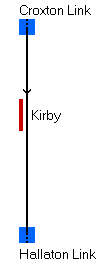Timetable Tutorial 2 – Enter, exit and repeat
This is similar to tutorial 1 except that some new features are included – a ‘Pass’ time is included for Kirby, and a command is given to repeat the service every minute.
Service data is as before

| Open railway.exe and click |
Load railway |
| Click |
As for Tutorial 1 |
| Click |
|
| Type 06:00 then Click |
|
| Click |
|
| Type *Train 1A20 enters at 06:00 and leaves at 06:01 at constant speed of 120km/h, followed by a total of 20 repeating trains at 1 minute intervals, with headcodes that increase by one digit at each repeat. Then Click |
|
| Click |
As for Tutorial 1 |
| Type 1A20;Croxton to Hallaton;120;120;250;25;2500 then Enter | |
| Type 06:00;Snt;3-4 3-5 then Enter | Start command |
| Type 06:00;pas;Kirby then Enter | This is the ‘Pass’ command. No action is taken by the timetable other than to record the passing time in the performance log |
| Type 06:01;Fer;3-17 then Enter | As for Tutorial 1 |
| Type R;1;1;20 then Enter | This is the ‘repeat service’ command. The ‘R’ identifies it as a repeat command, the first ‘1’ is for 1 minute between each repeat (the minimum is 1 minute), the next ‘1’ is the number by which the headcode is to be incremented for each repeat (this may be 0 if the same headcode is to be used), and 20 is for a total of 20 repeats, i.e. 21 trains in all including the first one. The general form of this command is ‘R;mins;digits;repeats’, and it must be the last command in the list. |
| Click |
|
| Click |
|
| Name it Crox-Hall 2.ttb then click Save | |
| Click |
As for Tutorial 1 |
Repeats are ideal as here when trains exit the railway, because then there is no interference with existing trains (unless they have been delayed and are still present and in the way when later ones appear). If trains don’t exit the railway then repeats will still work, but the number of trains on the railway will increase as time goes on and may well interfere with the new trains that are created or enter.
Hopefully this example shows how easy it is to create repeating services – it can save a very great deal of time during timetable creation !